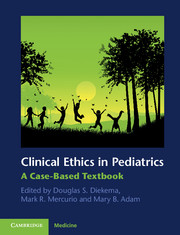Book contents
- Frontmatter
- Contents
- Contributors
- Preface
- Section 1 Core issues in clinical pediatric ethics
- Section 2 Ethical issues at the beginning of life: perinatology and neonatology
- Section 3 When a child dies: ethical issues at the end of life
- 18 End-of-life care: resolving disputes over life-sustaining interventions
- 19 Futility
- 20 Advance directives and DNR orders
- 21 The determination of death
- 22 Physician-assisted dying in children
- 23 The Groningen Protocol
- 24 Defining beneficence in the face of death: symptom management in dying children
- Section 4 Ethical issues posed by advances in medical technology and science
- Section 5 Children, public health, and justice
- Section 6 Special topics in pediatric ethics
- Index
- References
21 - The determination of death
from Section 3 - When a child dies: ethical issues at the end of life
Published online by Cambridge University Press: 07 October 2011
- Frontmatter
- Contents
- Contributors
- Preface
- Section 1 Core issues in clinical pediatric ethics
- Section 2 Ethical issues at the beginning of life: perinatology and neonatology
- Section 3 When a child dies: ethical issues at the end of life
- 18 End-of-life care: resolving disputes over life-sustaining interventions
- 19 Futility
- 20 Advance directives and DNR orders
- 21 The determination of death
- 22 Physician-assisted dying in children
- 23 The Groningen Protocol
- 24 Defining beneficence in the face of death: symptom management in dying children
- Section 4 Ethical issues posed by advances in medical technology and science
- Section 5 Children, public health, and justice
- Section 6 Special topics in pediatric ethics
- Index
- References
Summary
Case narrative
She had planned to leave him; take her 3-year-old son somewhere safe. Her husband (the child’s father) returned to the apartment in the early evening in the full throes of a paranoid psychosis, fueled by a prolonged binge on alcohol and methamphetamine. The mother and child were found the following morning. She was in a coma, suffering from hemorrhage of her liver and spleen after blows to her head had caused loss of consciousness and kicks to her abdomen had ruptured organs. The boy was also comatose. He had struck the side of his head on the edge of a wall, thrown there by his father after trying to intervene. His extradural hemorrhage had plenty of time to expand, and his brain to shift, herniate, and infarct. The diagnosis was not difficult for the neurosurgery or emergency room teams, but following surgery, the boy arrested in the recovery room and, although eventually resuscitated, was asystolic for at least 30 minutes. He was now intubated, ventilated and receiving full vasopressor support. Twelve hours later, a rigorous examination showed no signs of brain activity, and a repeat examination 30 hours later was unchanged. The boy’s next of kin was the father, the violent offender, recently arrested and placed in jail. The paternal grandparents were constantly present at the child’s bedside, often praying together. They did not believe the child was dead as he was clearly warm, breathing with a ventilator, and had a heartbeat.
Introduction of issues and historical context
The question that is raised in this chapter is whether we can and ought to declare death when we reliably recognize the existence of brain death, or total brain failure that is irreversible. It is not the concept and consequences of death which are in question. Death is existential, an inevitable part of living. Its consequences may be viewed differently, but its existence is certain. These consequences may be interpreted as biological by medical scientists, or simply as a transition in religious traditions (Miller & Ashwal, 2009). Philosophers might state that it is the loss of a person’s interests and obligations owed them as these depend on qualities possessed only by the living, and the anthropologist will appreciate the customs, norms, rituals, and prohibitions that surround death, as well as the initiation of a social event and a ceremonial process (Kaufmann, 2003). Legally its determination is required to allow burial or cremation, an autopsy, organ transplantation, inheritance, and when a spouse may remarry. It may also trigger an investigation as to whether the death was criminal or accidental, natural or suicide.
- Type
- Chapter
- Information
- Clinical Ethics in PediatricsA Case-Based Textbook, pp. 118 - 122Publisher: Cambridge University PressPrint publication year: 2011
References
- 2
- Cited by



